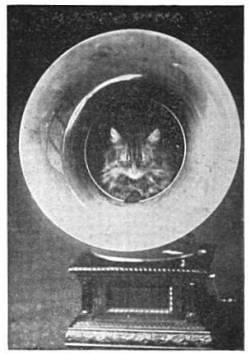
This cat has a liking for the gramophone: it loves to get in the trumpet to sleep, and will not move even when a record is put in and played!
— Strand, August 1906

This cat has a liking for the gramophone: it loves to get in the trumpet to sleep, and will not move even when a record is put in and played!
— Strand, August 1906
A curious legend attends the Viscounts Gormanston of Ireland. It is said that when the head of the house dies, the foxes leave the surrounding countryside and congregate at the door of the castle. The following statements, collected at the death of Jenico William Joseph, the 14th Viscount Gormanston, on Oct. 28, 1907, appeared in the New Ireland Review of April 1908:
“We venture no comment on the evidence,” the editors write. “Our readers will appreciate it for themselves. Whatever be their interpretation of the facts, they will, at least, allow that in them there is something of the marvellous.”
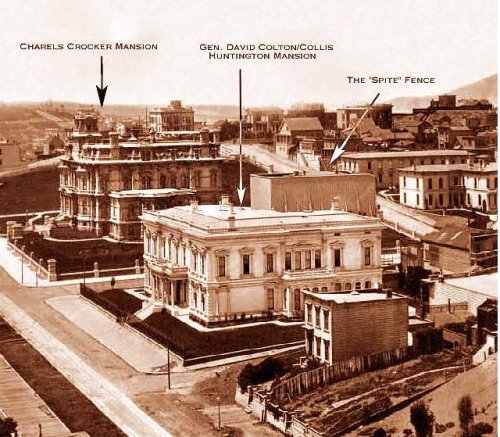
In 1878, railroad millionaire Charles Crocker decided to buy up the lots surrounding his mansion on San Francisco’s Nob Hill to improve his view of the surrounding vistas. He reached agreements with all the neighbors except for German undertaker Nicholas Yung, who refused to sell.
“I would have been happier than a condor in the sky,” Crocker wrote, “except for that crazy undertaker.”
His solution was pure spite: He built a 40-foot fence around Yung’s cottage on three sides, spoiling his view in hopes that he would sell. The fence can be seen behind the central mansion in this photo; only the chimneys of Yung’s house project above it.
“How gloomy our house became, how sad,” Yung’s daughter later wrote. “All we could see out our windows was the blank wood of the rich man’s fury. … The flowers in the garden all died, and our lawn turned brown, while inside the house everything felt perpetually damp.”
Yung held out nonetheless — according to some reports he mounted a 10-foot coffin atop the wall facing Crocker’s house — and the two maintained a senseless deadlock for years. Yung died in 1880 and Crocker in 1888; only then, when the mansion was sold to a new owner, did Yung’s heirs relent and sell their lot.
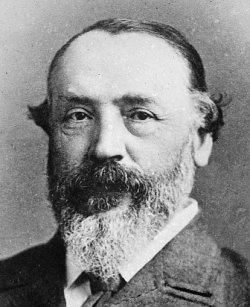
During the German siege of Paris in 1870, residents had to eat whatever animals were at hand. Daily News correspondent Henry Labouchère recorded his opinions:
“This siege will destroy many illusions,” he wrote, “and amongst them the prejudice which has prevented many animals being used as food. I can most solemnly assert that I never wish to taste a better dinner than a joint of a donkey or a ragout of cat — experto crede.”
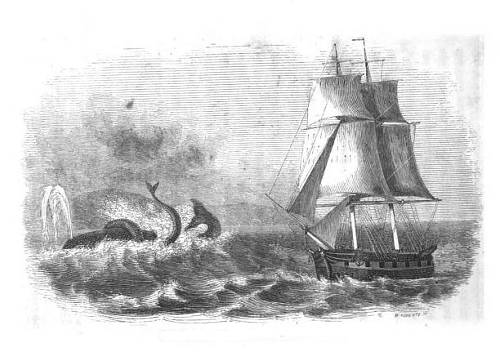
On the afternoon of June 21, 1818, the crew of the packet Delia, plying between Boston and Hallowell, Maine, came upon a struggle between a sea serpent and a large humpback whale, according to a statement sworn before a local justice of the peace. From Henry Cheever’s The Whale and His Captors (1850):
The serpent threw up his tail from twenty-five to thirty feet in a perpendicular direction, striking the whale by it with tremendous blows rapidly repeated, which were distinctly heard and very loud for two or three minutes. They then both disappeared, moving in a west southwest direction, but after a few minutes reappeared in shore of the packet, and about under the sun, the reflection of which was so strong as to prevent their seeing so distinctly as at first, when the serpent’s fearful blows with his tail were repeated and clearly heard as before. They again went down for a short time, and then came up to the surface under the packet’s larboard quarter, the whale appearing first and the serpent in pursuit, who was again seen to shoot up his tail as before, which he held out of water some time, waving it in the air before striking, and at the same time, while his tail remained in this position, he raised his head fifteen or twenty feet, as if taking a view of the surface of the sea. After being seen in this position a few minutes, the serpent and whale again sunk and disappeared, and neither were seen after by any on board.
Sea serpents, it seems, tend to win these contests — the English barque Pauline witnessed a similar drubbing half a century later.
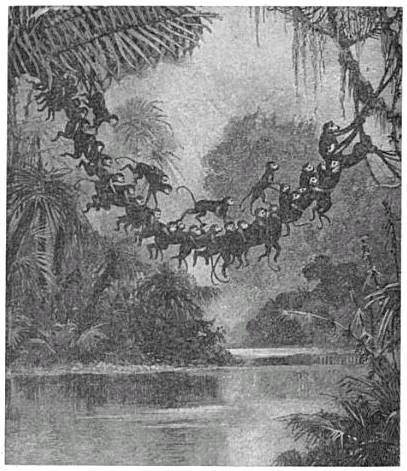
Do South American monkeys form living bridges in order to cross alligator-infested rivers? No modern naturalist thinks so, but the idea is curiously long-lived. Jesuit priest José de Acosta published the first account in Latin in 1589 — here’s a 1604 translation:
Going from Nombre de Dios to Panama, I did see in Capira one of these monkies leape from one tree to an other, which was on the other side of a river, making me much to wonder. They leape where they list, winding their tailes about a braunch to shake it: and when they will leape further than they can at once, they use a pretty devise, tying themselves by the tailes one of another, and by this meanes make as it were a chaine of many: then doe they launch themselves forth, and the first holpen, by the force of the rest, takes holde where hee list, and so hangs to a bough, and so helpes all the rest, till they be gotten up.
For a 1919 report in Natural History, biologist E.W. Gudger tracked down similar seemingly firsthand accounts by William Dampier’s navigator (1699), by Antonio de Ulloa (1735), and by Don Ramon Paez (1862) — but he concludes that they’re false: “Needless to say, this feat presupposes an amount of intelligence in the monkey family that it has never been known otherwise to exhibit, while aside from that, it is palpably impossible because nowhere in a tropical jungle could space be found in which to swing such a long chain as the story requires.”
Tiny Norfolk Island in the South Pacific has the world’s only telephone directory that lists people by nickname.
In 2007 these included Beef, Blitti, Booda, Bubby, Bugs, Bunt, Cane Toad, Carrots, Chilla, Chinny, Crowbar, Dar Bizziebee, Derms, Devil, Diddles, Diesel, Doby, Doodus, Dussa, Fishy, Frenzy, Gags, Geek, Girlie, Goof, Golla, Grin, Gumboots, Hat, Honkey-Dorey, Hose, Kik Kik, Kissard, Knuckles, Lettuce Leaf, Little Pooh, Loppy, Massport, Monkey, Moo, Nippa, Nuffka, Onion, Paw Paw, Philly, Plute, Possum, Puddles, Puffa, Pumbles, Pumpa, Pusswah, Rubber Duck, Skeeters, Slack, Smudgie, Snobbles, Sputt, Steggles, Storky, Toofy, Toyboy, Trigger, Truck, Ummy, Wiggy, and Yarm.
Many of the island’s residents are descended from the Bounty mutineers, who resettled from the Pitcairn Islands in 1856. Their European surnames are so common on the island that many go by adopted names.
UPDATE: I’m told that the Spanish village of Villanueva del Trabuco, in Andalucía, has a nickname-based phone directory that runs to 30 pages. The population is 5,000, about twice that of Norfolk Island.
(Thanks, Toño and Lucía.)
Capt. Edwards, of the fishing smack Amelia, reports that when off ‘Skunnett,’ on the Rhode Island shore, some time since, he discovered an object swimming off his bow which he finally made out to be a horse. He made sail but could not overhaul the animal, which was making desperate struggles to reach the main land three miles away. At times he would disappear from sight in the waves which broke over him,–the sea running very high at the time,–but a moment later would reappear, and with a loud snort and toss of the head, would shake off the water from his ears and eyes, and then renew the struggle. At last he made the shore, and, without pausing a moment, dashed up the beach, his long tail and curling mane floating outward on the wind. The splendid animal was possessed of immense strength, else he could not have swam that long distance in such a sea. Where he came from nobody knows. No vessel was in sight from which he could have escaped.
— James Baird McClure, ed., Entertaining Anecdotes From Every Available Source, 1879
On July 17, 1945, Suite 212 of Claridge’s Hotel in London became part of Yugoslavia.
Queen Alexandra was giving birth, and Winston Churchill made the concession so that the new prince could be born on Yugoslavian soil.
Lake Huron’s Manitoulin Island contains a lake of its own, Lake Manitou. Lake Manitou is the world’s largest lake-on-an-island-in-a-lake.
Lake Manitou itself contains two islands; each is thus an island in a lake on an island in a lake.